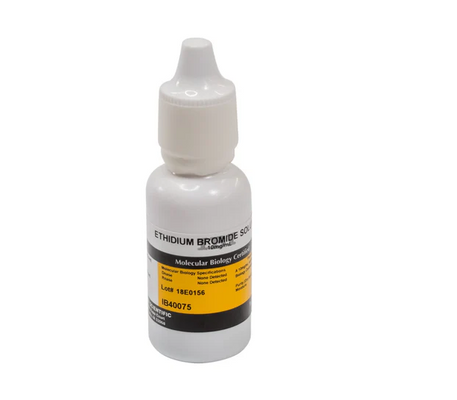
What is Ethidium Bromide?:
Ethidium bromide (EtBr) is a commonly used fluorescent dye in molecular biology laboratories for visualizing nucleic acids such as DNA and RNA. Its distinctive orange fluorescence under ultraviolet (UV) light has made it an indispensable tool for various applications, including gel electrophoresis and nucleic acid staining. In this blog post, we'll explore the details of ethidium bromide, how it works, its recommended use, and the potential dangers associated with its improper handling.
Understanding Ethidium Bromide:
Ethidium bromide is a small, planar molecule that readily binds to nucleic acids through intercalation, inserting itself between adjacent base pairs of DNA or RNA. This intercalation results in a significant increase in the fluorescence of the bound nucleic acid when exposed to UV light, allowing for easy visualization and detection. Ethidium bromide can be used to detect both single- and double-stranded nucleic acids (both DNA and RNA). However, it's important to note that ethidium bromide does not intercalate into single-stranded DNA very well, leading to relatively poor fluorescence compared to double-stranded DNA.
How Ethidium Bromide Works:
The mechanism of ethidium bromide's fluorescence involves the interaction between the dye and the nucleic acid. When ethidium bromide binds to DNA or RNA, it undergoes a conformational change that enhances its fluorescence emission when exposed to UV light. This fluorescence can be visualized using specialized equipment such as UV transilluminators or gel documentation systems, allowing researchers to analyze and quantify nucleic acids separated by gel electrophoresis. The image below shows the molecular formula of Ethidium Bromide.

Recommended Use of Ethidium Bromide:
Ethidium bromide is typically added to agarose or polyacrylamide gels during gel electrophoresis to visualize nucleic acids. It is usually included in the gel matrix or staining solution at a concentration ranging from 0.5 to 1.0 μg/mL. After electrophoresis, the gel is submerged in a solution containing ethidium bromide, allowing the dye to intercalate into the DNA or RNA bands. The gel is then illuminated with UV light, causing the ethidium bromide-bound nucleic acids to fluoresce, making them visible as distinct bands.
Dangers of Ethidium Bromide:
While ethidium bromide is widely used in molecular biology laboratories, it is important to handle it with caution due to its potential health hazards. Ethidium bromide is a mutagen and a suspected carcinogen, meaning it has the potential to cause genetic mutations and increase the risk of cancer with prolonged exposure. Direct contact with ethidium bromide or inhalation of its fumes should be avoided, and appropriate personal protective equipment (PPE) should be worn when handling the dye.
Furthermore, ethidium bromide waste should be properly disposed of according to local regulations to prevent environmental contamination. Many laboratories now use safer alternatives to ethidium bromide, such as SYBR Safe or GelRed, which offer comparable fluorescent properties without the associated health risks.
IBI Scientific Ethidium Bromide:
IBI Scientific's Ethidium Bromide is a valuable tool in molecular biology research, allowing for the visualization and detection of nucleic acids with high sensitivity. Its fluorescence properties make it ideal for applications such as gel electrophoresis and nucleic acid staining. However, it is essential to handle our ethidium bromide with care and follow proper safety protocols to minimize the risks associated with its use. By understanding its properties and potential hazards, researchers can continue to harness the power of IBI ethidium bromide while ensuring a safe laboratory environment.Sources:
1. Green, M. R., & Sambrook, J. (2012). Molecular cloning: a laboratory manual. Cold Spring Harbor Laboratory Press.
2. "Ethidium Bromide Safety Data Sheet." Sigma-Aldrich. [Link](https://www.sigmaaldrich.com/MSDS/MSDS/DisplayMSDSPage.do?country=US&language=en&productNumber/E8751&brand=SIGMA&PageToGoToURL=https%3A%2F%2Fwww.sigmaaldrich.com%2Fcatalog%2Fproduct%2Fsial%2Fe8751%3Flang%3Den)
3. Guranowski, A. (1987). "Ethidium bromide: historical and toxicological issues". Mutat Res. 186 (1): 29–41.


